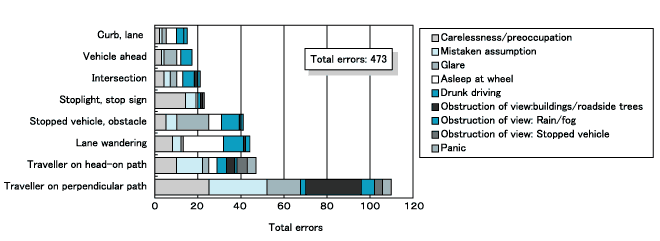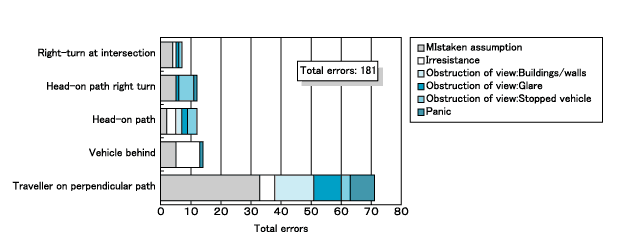Perception consists of drivers identifying and becoming aware of irregularity and danger in surrounding traffic conditions, and
judgement of taking decisions on how to react to the situation perceived. Execution of driving operations in accordance with that
judgement is generally termed operation. However, we elected to include within "judgement" in the above system of categorization
the predictive behavior of defensive driving consisting of the judgement that, while no danger may presently be apparent at an
intersection, someone might appear from around a corner, and to treat this category as one of judgement and prediction.
We refer to the principal party in an accident as Party A and to the other party in a collision as Party B. In other words, all accidents
that are not single-vehicle accidents involve another party in the collision (including pedestrians and other vehicles).
Of the 300 accidents in 1997, for example, 75 were single-vehicle accidents and so there were 300 Parties A and 225 Parties B.
|
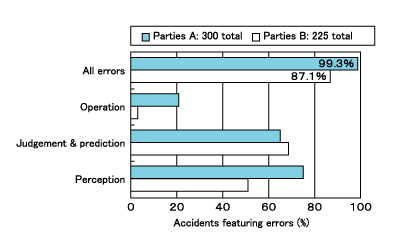 |
| Figure 1 -- Frequency of Errors, by Party to Accident |
Figure 1 shows, of the 300 Parties A and the 225 Parties B, what proportions committed some sort of error. 298 Parties A, or
almost the total number, and 196 Parties B, or 87% of the total, committed an error. Errors of perception (oversight) were most
common among the Parties A,indicating that the most effective way to prevent accidents would be to improve their ability to
perceive (identify) signs of danger. Unlike the Parties A, the Parties B exhibited a greater proportion of errors of judgement and
prediction than of errors of perception. That is, it would seem to be of greater importance among Parties B to judge and predict
situations correctly or, in other words, to make judgements and predictions that lead to safer driving, to take care to drive defensively.
Nor do these errors occur singly. As shown in Figures 2 and 3, in the majority of accidents errors of judgement or prediction and
errors of operation occur together with errors of perception. For reference, Figure 4 shows the numbers of errors committed per
party involved in an accident. Parties A committed around three errors each, and Parties B around two errors each. In other
words, the Parties A had around three opportunities to avoid the accidents, and the Parties B around two such opportunities.
|
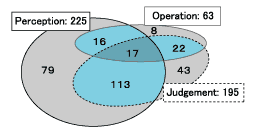 |
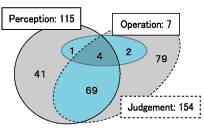 |
| Figure 2 -- Dominant Circumstance of Party A Errors |
Figure 3 -- Dominant Circumstance of Party B Errors |
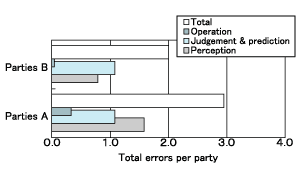 |
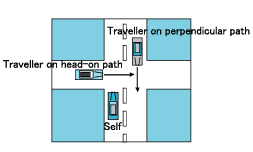 |
| Figure 4 -- Errors per Party to Accident |
N.B. Definitions of straight-line intersection and oncoming approaches |
|
 1.1 Errors of Perception: Carelessness and mistaken assumptions 1.1 Errors of Perception: Carelessness and mistaken assumptions
 1.2 Errors of
Decision-making and Prediction: Mistaken assumptions 1.2 Errors of
Decision-making and Prediction: Mistaken assumptions
 1.3 Errors of Operation: Flurry, panic and mistaken assumptions 1.3 Errors of Operation: Flurry, panic and mistaken assumptions |
| UP |
|
| 1.2 Errors of Decision-making and Prediction: Mistaken assumptions |
| Next, we consider errors of decision-making and prediction and the factors contributing to those errors. |
Figure 7 summarizes the main results obtained for Parties A. The most common error of
decision-making and prediction is that despite being aware of an
intersection, they saw no other vehicle and so assumed "no one would be on the intersecting road", another mistaken assumption that leads to sideswipe collisions.
It serves to look back at Figure 5 at this point. Although travellers on a perpendicular path are often overlooked, intersections per se are rarely overlooked.
This means that there is not a little possibility that errors of perception with respect to travellers on a perpendicular path could be resolved by making the
safety-oriented decision-making and prediction that "there could be someone on the intersecting road", i.e. taking care to drive defensively, at the point of
perceiving an intersection, rather than assuming "no one would be on the intersecting road". What is important is the need, whatever contributing factors
may obtain and even when an error of perception obtains, of looking at another object and predicting the presence of objects that were not perceived.
The attitude that "my own car's speed is not a problem", which leads to single-vehicle accidents, is present is about the same number, and both suggest
decision-makings and predictions that are subjectively convenient.
Mistaken assumptions are everywhere in factors contributing to errors, accounting for 60% of the total: "I've got the right of way so no one's going to
intrude", for example, or "I've got the green light so no one's going to intrude".
|
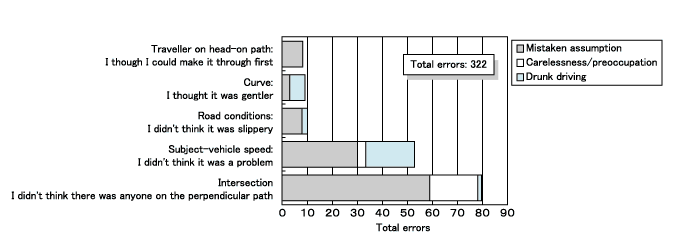 |
| Figure 7 -- Errors of Decision-making and Prediction and Contributing Factors(Parties A) |
On the other hand, as we see in Figure 8, the most common error of
decision-making and prediction by Parties B was the assumption, on seeing an intersection,
that "no one's going to obstruct my path", followed by the assumption, on seeing a traffic signal, that "no one's going to ignore the signals".
The contributing factor leading to almost all such errors is mistaken assumptions.
The point is that there is a need to take care to drive defensively in light of a recognition of the fact that not everybody obeys signals and other traffic
regulations. Even so, 8% of all contributing factors to errors by Parties B consist of irresistance, in which the Party B could pursue no other course.
In short, the significant contributing factor in errors of decision-making
and prediction is, as in errors of perception, mistaken assumptions on the part of the driver
and need not be remarked on particularly here.
|
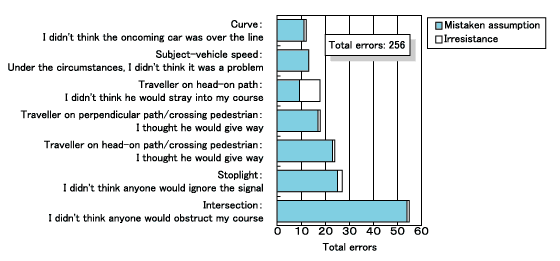 |
| Figure 8 -- Errors of Decision-making and Prediction and Contributing Factors(Parties B) |
| UP |
|
| 1.3 Errors of Operation: Flurry, panic and mistaken assumptions |
| There are not many errors of operation, but for reference purposes Figure 9 gives errors of operation by Parties A and the factors
contributing to those errors. Almost all of the errors involve the steering wheel; the factors contributing to them were, in order of
frequency, insufficient driving ability, flurry and panic, drunk driving, overconfidence in control of vehicle, and falling asleep at the wheel.
The total number of errors of operation by Parties B is a very low nine and so no figure is presented. The most common such error
was three instances of headlights off, followed by two each of unsuitable operation of steering wheel and brake.The factors contributing
to these errors were, in order of frequency, flurry and panic, and mistaken assumptions.
In short, while there are few errors of operation per se, the fact cannot be overlooked that most of these involve a contributing factor
attributable to the driver in which a Party A commits an error using the steering wheel. |
 |
| Figure 9 -- Errors of Operation and Contributing Factors (Parties A) |
| UP |



 1.1 Errors of Perception: Carelessness and mistaken assumptions
1.1 Errors of Perception: Carelessness and mistaken assumptions 1.2 Errors of
Decision-making and Prediction: Mistaken assumptions
1.2 Errors of
Decision-making and Prediction: Mistaken assumptions 1.3 Errors of Operation: Flurry, panic and mistaken assumptions
1.3 Errors of Operation: Flurry, panic and mistaken assumptions